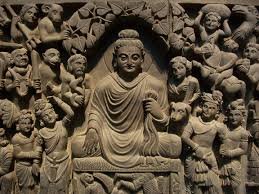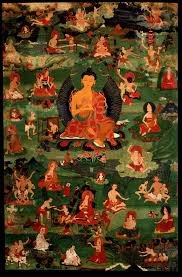The Two Main Schools of Buddhism and Other Buddhist Beliefs
Buddhist Schools

The Theravada. The word theravada means Way of the Elders. The Theravada school is the only one of the early Buddhist schools that has survived. Today, it is the dominant religious tradition in Burma, Cambodia, Laos, Sri Lanka, and Thailand.

The Theravadans emphasize the importance of Buddha as a historical figure, the virtues of the monastic life, and the authority of the Tripitika. For them, the ideal Buddhist is a kind of saint called an arhat. Mahayanists and others have often referred to the Theravada and similar schools as Hinayana, a term that means lesser vehicle.

The Mahayana. The word Mahayana means great vehicle. Most followers of the Mahayana live in Japan and in the other countries of East Asia. The Mahayanists emphasize the existence of many Buddhas. They often focus attention on Buddhas in heaven and on people who will become Buddhas in the future. The Mahayanists believe that these present and future Buddhas are able to save people through grace and compassion. Most Mahayanists accept many of the Hinayana scriptures, but they believe that their own scriptures reveal a higher level of truth. The Mahayanists teach various ways in which the laity, as well as monks, can achieve nirvana.
The Mahayanists encourage everyone to follow the ideal of the bodhisattva. A bodhisattva is a person who vows to become a Buddha by leading a life of virtue and wisdom. At the highest level, a bodhisattva is one who postpones entering into nirvana in order to work to relieve suffering through acts of love and compassion.
Bodhisattva, pronounced boh dee SAHT vuh, in the Buddhist religion, is a person who strives to become a Buddha. Buddhists believe that Buddhas have developed certain moral and religious perfections, and have reached a state of complete enlightenment and peace called nirvana. Bodhisattvas vow to reach nirvana, but to delay entering it in order to work for the salvation of others. To achieve this goal, a bodhisattva follows Buddhist ways of life called the Middle Way, the Noble Eightfold Path, and the Bodhisattva Path.
Dharma, pronounced DAHR muh, is the moral and religious law of Buddhism and Hinduism. Each of these religions has its own dharma.

In Buddhism, the dharma is reflected in the teachings of Buddha, who founded the religion. The principles of the Buddhist dharma govern daily life and show the way to salvation. Buddha preached that life is a continuing cycle of death and rebirth. He taught that by following Buddhist ways of life called the Middle Way and the Noble Eightfold Path, a person could overcome suffering and achieve nirvana, a state of peace and happiness. Buddha's followers compiled his teachings in a scripture called the Tripitika.
Karma, pronounced KAHR muh, is an important concept in several Eastern religions, especially Hinduism, Buddhism, and Jainism. Followers of these religions believe that existence is a continuing cycle of death and rebirth. They teach that the conditions of a person's life result from his or her karma (deeds) in previous lives. Similarly, people's present actions determine their future destinies in this world, in heaven, or in hell.
Karma determines the form in which a person will be reborn. Good deeds lead to rebirth in a higher state, perhaps as a wealthy person. Evil deeds may lead to rebirth as a slave or even as an animal. Thus, beliefs about karma both encourage ethical behavior and explain what appear to be unfair conditions in society. Buddhists, Hindus, and Jains agree that the highest religious goal is to end all attachments to worldly things and so free oneself from the effects of karma. The person then achieves a higher level of experience, called moksha (liberation) which leads eventually to Nirvana.
Nirvana, pronounced nihr VAH nuh, according to Buddhist belief, is perfect peace and blessedness. The attainment of nirvana enables a person to escape from a painful, continuous cycle of death and rebirth. This cycle is caused by an individual's worldly desires, such as a craving for fame, immortality, and wealth. People attain nirvana when such desires are completely eliminated. When they die, their cycle of death and rebirth ends.
Buddha, the founder of Buddhism, preached that nirvana can be attained by following a Middle Way between self-indulgence and self-denial, and by practicing the Noble Eightfold Path. The Noble Eightfold Path consists of eight aspects of correct living, including proper behavior, proper meditation, and proper insight into truth.

To listen to the audio version of this article click on the play image.

Brought to you by @tts. If you find it useful please consider upvoting this reply.
Thanks, great article! What happened to the other early schools?
Congratulations @mayushi! You received a personal award!
You can view your badges on your Steem Board and compare to others on the Steem Ranking
Vote for @Steemitboard as a witness to get one more award and increased upvotes!